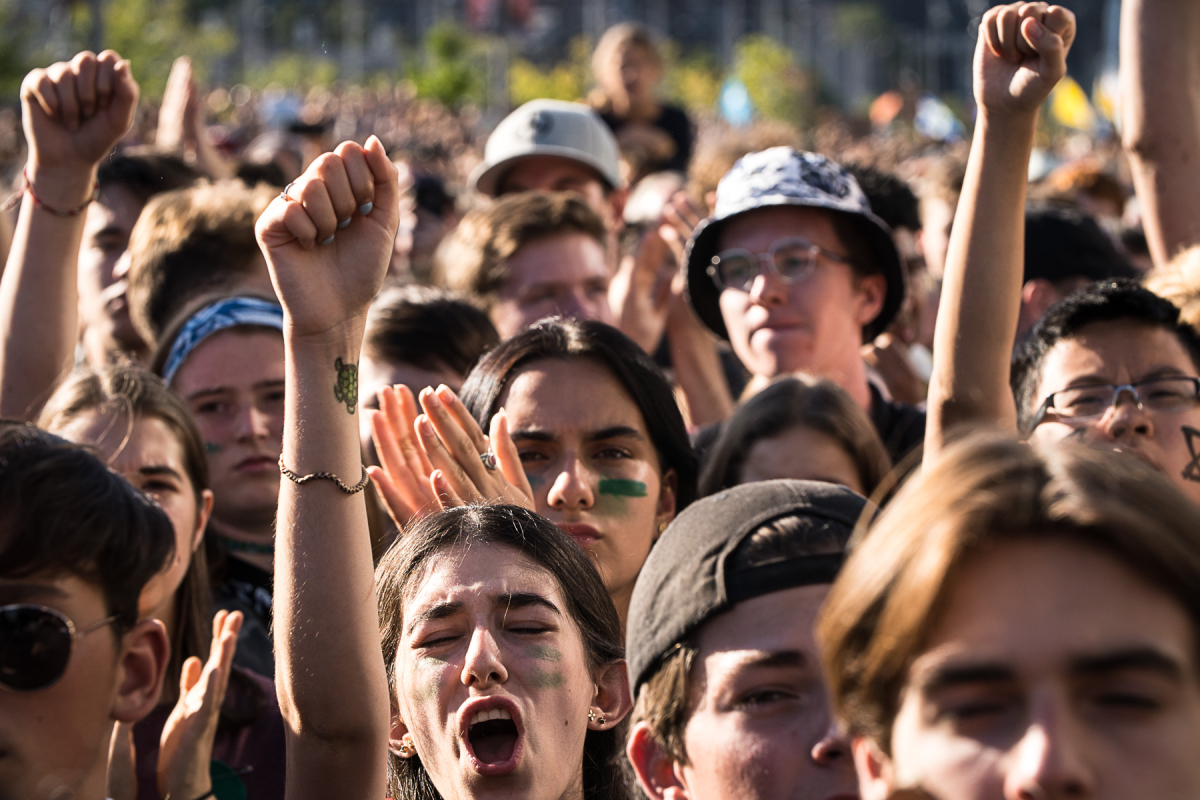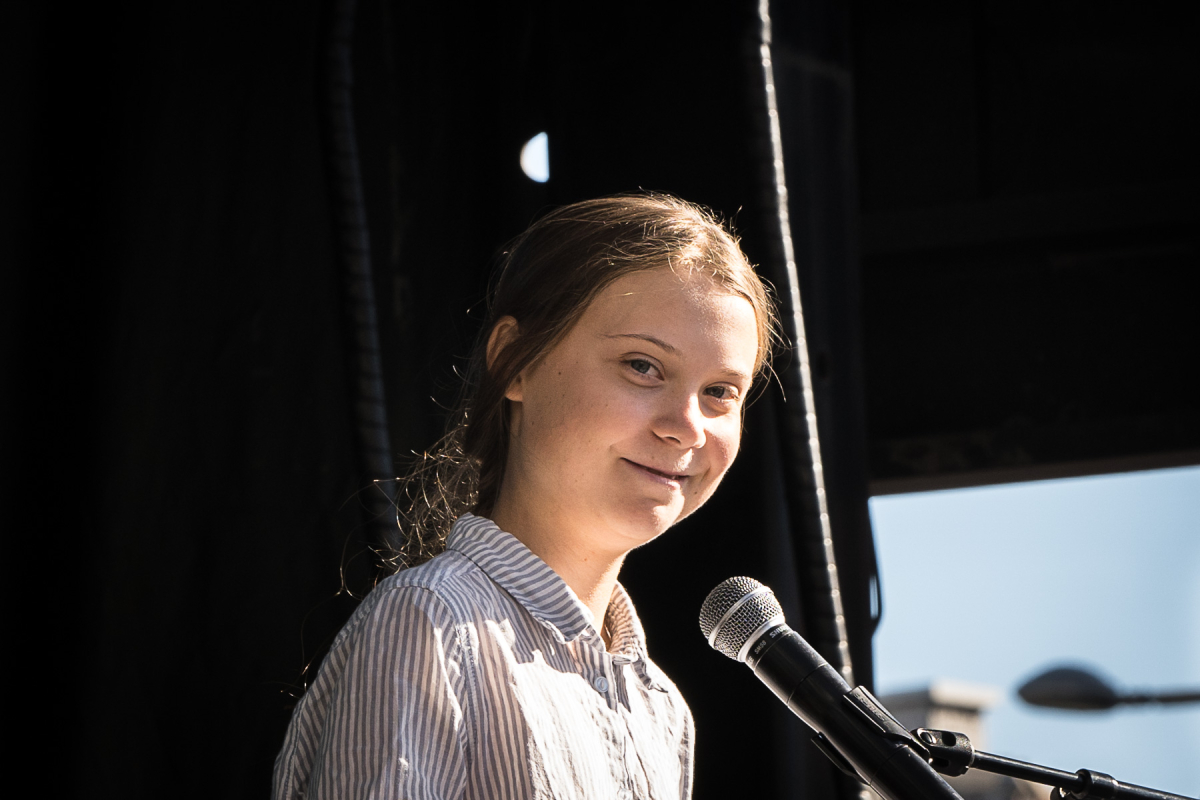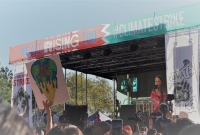Support strong Canadian climate journalism for 2025
When it was announced a few months ago that Swedish activist Greta Thunberg had accepted an invitation by Montreal-based environmental activist student group La Planète s’invite au Parliament to march as part of a global climate strike, we all knew it was going to be momentous.
Yesterday’s “Fridays for Future” was largely expected to be the largest climate change march in the country. According to the organizers, not only was it the biggest protest in Quebec history, it was also the biggest climate protest worldwide this month.
Half a million people descended on the streets of Montreal on Sept. 27, the organizers said, to call on politicians to do more to tackle climate change.

People of all ages and all backgrounds gathered
In anticipation of the big day, Montreal Mayor Valérie Plante announced that public transit and bicycle sharing system Bixi would be free for the day, in order to encourage everyone to leave cars at home and join the march.
Several school boards, universities and other educational institutions in Montreal cancelled classes. Many businesses also closed their doors for the day, encouraging staff to attend the historic event.
I was already in the metro, on the way to the climate march, by the time I absentmindedly looked down at the cup of coffee I had picked up in a hurry at my local café.
The cup was recyclable, but the plastic lid was conspicuously not. I hadn’t even made it to the march, and I felt like I had already failed the credibility test.
Perhaps events like these are primarily aimed at forcing us to take a good, hard look at our own harmful habits, shaming us into action.
By the time I reached the Sir-George-Étienne Cartier monument on Avenue du Parc, at the foot of Mont Royal, I knew this event was going to be both huge and diverse.
People of all ages and all backgrounds were gathered, patiently waiting for the start of the march. More kept coming and there didn’t seem to be an end in sight.

'Learn to change, or learn to swim'
The student contingent was everywhere — and it was loud. Dancing, chanting, carrying loudspeakers and drums. Some of the signs were caustically angry, some were hopeful, and most were humorous with a level of creativity that was highly entertaining:
“Learn to change, or learn to swim"; “I ditched school because you ditched my future”; “Maybe if it was called Father Earth, you’d give a shit”; "What use is a diploma if I don’t have a future?”
A young, shirtless man perched on his friend’s shoulders had “Winter Wear 2030” scribbled on his bare chest in black marker.
There were multiple signs reminding us that Greta is vegan, asking, “Do you really love hamburgers more than the earth?”
Our Canadian tendency to apologize occasionally slipped out. “Sorry for the inconvenience, we’re here to save the world,” said another sign.

Festive mood, but gravity of moment understood
I find myself at the tail end of the march. During the long wait at Avenue du Parc to get going, I watch everyone around me. Despite the impossibly crowded conditions and the accidental elbow bumping, everyone is in a jovial, festive mood.
I watch as a group of young teens pull and prod at a Liberal campaign poster featuring Prime Minister Justin Trudeau that’s attached to a light post and then, with one final jerk, manage to remove it. I see the poster disappear into the crowd amid loud cheers. I see that happen twice more.
Virginia Champoux is marching with her two teenaged girls. She says she’s here because “the level of changes we all have to make are a lot bigger than just plastic straws and taking the bus.”
While they do what they can to make a difference — eat less meat, reduce and reuse, have a hybrid electric vehicle as a family car — she doesn’t think it will be enough. “The Amazon is burning, the ice caps are melting, and not enough people are concerned.”
Sarah, her sixteen-year-old daughter is carrying a sign that says, “I will clean up my room when you clean up your shit.” She says she’s here to remind people that climate change is happening and that we need to fix it as soon as possible. She also wants to hear Greta speak.
NJ, her 14-year-old sister says that older generations don’t seem to be thinking enough about younger generations and how they will be living in a polluted environment. “We’ll have to pick up the slack if we still want human life in 100 years,” she says. “We will be voting soon, and we need to look at politicians who will help our country pollute less.”
A senior woman marching quietly behind me with her friend refuses to give me her name but tells me her age: 77. When I ask her why she’s marching, she quickly replies: “Guilt, I suppose.” She tells me that, when they were around the age of the students marching, they were oblivious to the problem.
“We’re leaving a mess for them. I have grandchildren who live in coastal areas...this march is for them.”

'I am marching for the youth and their dreams'
Holly Friesen is a professional landscape painter. Her work, featuring depictions of forests, lakes, and trees, is a celebration of the world’s natural beauty. She’s used her skills to paint a large colourful canvas protest sign that politely says: “Do everything YOU CAN with everyone to CHANGE EVERYTHING you can.”
“I’m marching for the natural world and non-human species who have been considered inert commodities instead of the living, sentient beings they are, for far too long,” she says.
“I am marching for the youth and their dreams and I’m marching for unborn generations who have a right to coexist with this magnificent planet as much as us. I want to see a complete overhaul of the system and the way things are currently done.”
My attempts to live-tweet the march keep failing as the cell network is overloaded, but I still manage to catch a glimpse of a few drone shots posted by Radio-Canada and CBC on Twitter.
The aerial views of the throngs of people marching down Avenue du Parc are awe-inspiring. It’s hard to wrap my head around the fact that I’m a tiny dot somewhere in that mighty mass moving along at a snail’s pace.
People have been marching for hours and I barely feel like we’ve moved more than 500 metres. It makes me proud that Montrealers have come out to make such a strong statement, but I’m starting to feel a little claustrophobic.

Trash piles did not materialize as predicted
As a neuropsychologist, Vivian Akerib is focused on mental health – her son’s and the world’s. “I’m here because I have a son and I want him to have a future,” she says.
“We are ruining, not only our physical health, but our mental health as well with our actions. It’s all connected… how we take care of earth, how we take care of the animals, it affects us all. I know my son is worried and I know he’s serious about change.”
Asked if she thinks any of this will make a difference, she quickly replies, “Oh, I certainly hope so!"
"I hope this isn’t for show and I hope things change. I see young people suffering from eco-anxiety these days...we didn’t even study this in university, this is new. I’m not even sure how to treat it. I can’t think of anything worse than young people feeling despondent and hopeless. We need for things to change.”
Despite the cynical comments I saw on social media, predicting that marchers would leave behind a wake of garbage that city workers would be forced to clean up, I saw the contrary.
Two young people with garbage bags are busy cleaning up garbage that I’m positive has nothing even to do with this march. I see no signs of littering or careless, entitled behaviour exhibited. Even the Montreal police and public transit workers are on their best behaviour, smiling and patient in a way I wish I could see more often.
Rows and rows of Bixi bikes are lined up near Pine Avenue, and it’s obvious that Montrealers have heeded the mayor’s call to use them to get to the march. A Bixi brigade is standing guard over the bikes that keep piling up.
I know Greta doesn’t like depictions of her as a heroine, because she’s always urging us to save ourselves, but someone goes by me with a large, beautifully illustrated poster depicting the climate activist as Joan of Arc.

Greta depicted as Joan of Arc
Her stance in the image is warrior-like, her gaze piercing and steadfast. It’s a gorgeous image and it manages to communicate Greta’s laser focus and quiet determination that endears her to this crowd. They see her as someone who is genuinely fighting for a cause worth supporting, against all odds and all derision by men in power.
In a press conference before the march Greta is asked by a reporter: “Why do you think grown men in powerful positions are so afraid of you?"
“I don’t know why grown-ups would choose to mock children and teenagers for just communicating and acting on the science, when they could do something good instead,” she replies.
“But I guess that they might feel like their world view or their interests are threatened by us. And that, we should take as a compliment, that we are having such an impact that people want to silence us.”
Greta spoke with Prime Minister Justin Trudeau privately ahead of the rally. After her meeting with Trudeau, who also walked with the crowds and his family in the Montreal march, Greta told reporters, “my message to all politicians is the same. Just listen to the science, act on the science.”
An anti-pipeline protester later attempted to throw eggs at Trudeau but was quickly intercepted by his security. Quebec Premier François Legault did not attend the march.

Canada's climate reputation means 'nothing'
Before we begin marching, Greta receives a gift from Assembly of First Nations National Chief Perry Bellegarde, who greets her as a “young warrior lady.”
Greta asked Indigenous youth to lead the Montreal march because “Indigenous people have for centuries and millenniums protected the local environment...they are at the front line, so we need to be able to hear their voices.”
Despite her young age, Greta seems incredibly aware of her privilege, and using every opportunity to point the spotlight at other activists of colour and amplify their voices.
The four-hour-long march along a four-kilometre route from Jeanne-Mance Park to Old Montreal ends with a rousing speech by Greta, who’s greeted by the huge crowds with the kind of enthusiasm usually reserved for rock stars.
Smiling shyly, she utters “Bonjour, Montreal” and then proceeds to list the ways Sweden and Canada are similar. Hockey, pine trees, moose, and cold winters, if you’re interested.
Then, her tone takes a serious turn and we’re quickly reminded why politicians fear her and why activists respect her.
“You are a nation that is allegedly a climate leader; Sweden is also allegedly a climate leader,” she says. “In both cases, it means absolutely nothing."
A thunderous roar erupts from the crowd. "In both cases, it’s just empty words.”

'We are the change, and change is coming'
The message the young environmentalist wants the political establishment to remember is simple: “We will not be silenced.”
She reiterates that throughout history, significant change has always come from the bottom up.
“If the people in power won’t take their responsibility, then we will. It should not be up to us, but somebody needs to do it. This is an emergency and we cannot be bystanders. We are the change, and change is coming.”
Everyone cheers again. The numbers start trickling in and she announces that 6.5 million people marched around the world for climate action. Montreal’s protest is confirmed as the largest in the country.
Was the “Greta factor” instrumental in getting this many people out? There’s no doubt. But those on the streets sound purposeful and committed to change. They were inspired by Greta, but actively looking for local solutions to a global crisis.

Montreal mayor calls Greta 'trailblazer'
Claudine Bonner isn’t a Montrealer. She’s a professor at Acadia University, in Nova Scotia, visiting the city. But since she’s here, she decided to attend the march. She’s listening enthralled to Greta’s speech, like the rest of us.
She believes that every generation has a moment, a tipping point where they need to face the enemies of their time. “For our parents, it was civil rights and the women’s movement,” she says.
“For our youth, it’s the Earth in crisis. What we’re doing is making and has made a difference. Now we need to make governments listen.”
After her speech, Greta quickly made her way to Montreal's City Hall where she met with Plante, the mayor, during a brief one-on-one private meeting.
Introducing her to the media, Plante refers to her as a “trailblazer” and then presents her with the keys to the city, an honour only seven people before her have been given in Montreal’s history.
Greta is quite diminutive up close and it’s astounding that someone so soft-spoken, so unassuming, has become such a role model for so many and such a target of vitriolic scorn for climate-change deniers.
She signs the Golden book and shortly after quietly slips out from the back while young activists waiting for her yell out that they love her.
Smiling shyly, she utters a barely audible “thank you” and proceeds to walk towards Champ-de-Mars metro station, on her way to most probably much-needed rest.

The sign that started it all
It’s already 6:30 p.m. and it’s been an incredibly long day. One can’t help but wonder how many times Greta has repeated this routine, and how many times she’s expected to repeat it in future.
Even for such a young person, the energy and focus it requires must be exhausting.
I watch her walk away, a tiny figure next to the tall police officers walking alongside her. She’s still holding her sign with “Skolstrejk för klimatet” scribbled on it tucked under her arm.
That sign that started it all...the one she held during that first protest in Sweden all alone, the one that sparked a global movement.






Comments